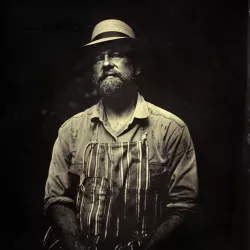
Recipient Information
Location
Mufreesboro, Tennessee
Medium
Wetplate Collodion Tintype
Year of Award
2020
Grant or Fellowship
Southern Prize and State Fellowships
Grant Amount
$5,000
Artist Biography
Bill Steber has documented blues culture in Mississippi for the last 20 years, chronicling the state’s blues musicians, juke joints, churches, river baptisms, hoodoo practitioners, traditional farming methods, folk traditions and other significant traditions that gave birth to or influenced the blues. The work is gathered in his exhibit “Stones in my Pathway” as well as in the pages of Living Blues magazine and other publications.
Steber, a native of Centerville, TN, was a staff photojournalist for the Tennessean in Nashville from 1989-2004, winning dozens of regional and national awards while shooting everything from national politics to New York runway fashion and the Super Bowl.
His latest passion is exploring 21st Century American culture through the use of 19th century wet plate photography, including tintypes, ambrotypes and glass negatives.
In addition to his photography, Steber makes music with The Jake Leg Stompers, the Hoodoo Men, The Jericho Road Show and The Worried Minds.
Artist Statement
My father first put a camera in my hand when I was 10 years old, an act from which I’ve never recovered. I’ve been documenting the South for most of my life: its people, its landscape, its traditions, its surprising beauty and its maddening contradictions. Vernacular culture is born of poverty mixed with genius, and the South has plenty of both to spare. It is the pursuit, preservation and celebration of that culture that drives my own creativity.
I come from a family that regarded creativity as something as natural as breathing. My own personal expression found voice in my love of photography, discovering that I could engage in the world in real time, in ways that engaged my subconscious and made me feel alive and connected.
Since 2005, I have been pursuing the use of 19th Century collodion wetplate photography for my Southern documentary work, discovering that the patience required for the difficult fieldwork and long exposures bring out in the subjects a deeper essence. Though cloaked in the visual artifice of an earlier time, I find that these tintypes and ambrotypes speak to themes that make the South unique, namely, connection to history, family, and the land. Or, as William Faulkner said, “The past isn’t dead. It isn’t even past.”
I draw great inspiration from the South, from the people, the stories, the landscape, the sad and beautiful history, but mostly, from the aspirations of those who love it as it is and seek to make it better.
You could be the next Southern Prize winner.
Interested in entering our competition? Submissions are open until the beginning of December. Review eligibility criteria, then get to work on your application.
Explore this Award








